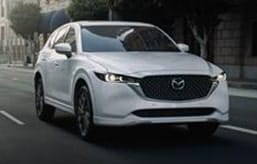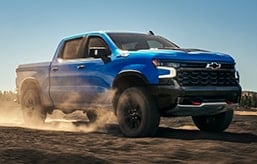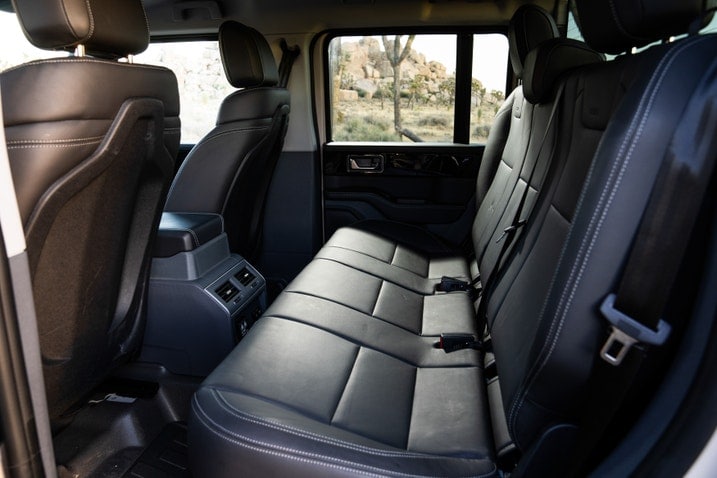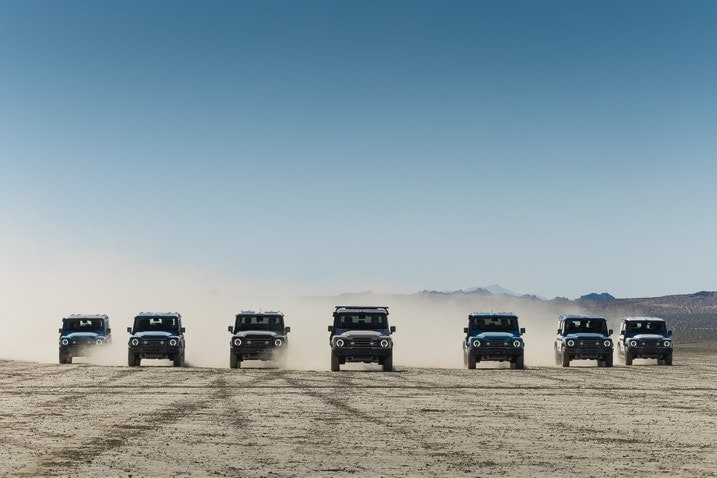- Pickup truck version of the Ineos Grenadier SUV
- Same BMW-sourced straight-six powertrain
- Airplane-inspired interior remains charming
- Subject to the chicken tax on overseas-built trucks
2024 Ineos Grenadier Quartermaster First Drive: Minimalist Truck, Maximalist Price Tag
The Grenadier Quartermaster offers the same pared-back driving experience as the SUV
Ineos' second vehicle will soon be arriving in the United States, and in many ways, the new one is a carbon copy of its first. The Quartermaster stretches out the vehicle significantly, and instead of a cargo area behind the back seat, there's a 5-foot bed for expanded utility. Edmunds recently had the Grenadier SUV in for testing to see how it performed on and off-road, so going into this initial drive of the Quartermaster, I had a bit more context than usual given their numerous similarities.
How it drives
The Quartermaster is powered by the same BMW-sourced powertrain found in the SUV: a turbocharged 3.0-liter straight-six mated to an eight-speed automatic transmission and a full-time four-wheel-drive system. This engine/transmission combination is well known to us, it can be found in a wide range of BMW products from the X5 and X7 SUVs to the 3 Series, 4 Series and even the Z4. But here in the Ineos, it has been modified and produces less horsepower for the sake of greater low-end torque. In the Grenadier, you've got 281 horsepower and 331 lb-ft.
The Quartermaster feels adequately quick on the road, but it's by no means fast. Ineos lists an estimated 0-to-60-mph time of 8.8 seconds for the truck, matching the SUV, and in our testing, the ute hit that time on the nose. I'd guess that the truck will end up being a little slower, given it's nearly 400 pounds heavier. I should also note that the SUV struggled with its braking performance, taking 152 feet to stop from 60 mph — a number that is likely to grow with the Quartermaster as well.
Driving the truck feels familiar to driving the SUV; the recirculating-ball steering gives the wheel some play at the top (like it does in the Wrangler) and it takes a good yank to get the nose to turn in. The Quartermaster also has the same quirk where the wheel does not unwind at times, so you can't just ease up your grip pressure and expect the wheels to turn back toward center (even while on the throttle).
Ride quality between the two vehicles is about the same, though the Quartermaster's lengthened wheelbase seems to add a touch of stability while cruising on the highway. The suspension setup features the same exact parts as the SUV's, but the rear springs have been dialed up to account for increased payload, and the rear end can get chatty over broken pavement as a result. I'm worried that the Quartermaster might struggle when it comes to towing anything near its 7,716-pound capacity — this will tax the powertrain and potentially cause a good amount of squat.
What's your angle?
The Quartermaster feels much larger on an off-road trail than the SUV, as it should, given that the wheelbase has been stretched by a full foot to 127 inches, and it's nearly 2 feet longer overall. You have to give sharp rocks or other obstacles a much wider berth before you turn in to avoid catching them. My test vehicle has the Rough pack, which adds front and rear differential lockers along with fantastic 31.6-inch BFGoodrich All-Terrain KO2 tires.
A notable difference between the SUV and the Quartermaster is in off-road geometry. Ground clearance is the same between the two at a robust 10.5 inches, and they have the same 36.2-degree approach angle. But thanks to that bed hanging out far over the rear tires, the Quartermaster's departure angle is much worse at 22.6 degrees, versus 36.1 degrees in the SUV. That just means you can take the SUV places that the truck can't handle without potentially dragging its rear skid plate on the way out.
With the Quartermaster in low-range four-wheel drive, its throttle reponse is (unsurprisingly) similar. When you're demanding even torque and power output at consistent throttle, it delivers with impressive smoothness. But tipping in the power to get a wheel up on a rock can be a bit testy; you end up having to use both feet to really crawl forward with dexterity.
Tightened confines
The Quartermaster retains the Grenadier's charming cabin, with its cockpit-inspired interior control scheme and the tiny "TOOT" button on the steering wheel that activates a soft horn to warn cyclists and pedestrians you're approaching. That also means the Quartermaster has some of the same annoying quirks, like a speed-limit warning system that must be shut off each time the vehicle is turned on and a hard-to-decipher panel of warning lights in front of the driver instead of an instrument cluster. (Your speedometer is in the center screen.) Thankfully, wireless Android Auto and Apple CarPlay also come along for the ride and work seamlessly, though there is no wireless charging pad so you'll need a cable to keep your phone juiced.
Even though the truck is much longer than the SUV, its cabin is smaller, and rear legroom is very tight. I'm just under 6 feet tall, and with the Recaro seat set to where I like to drive, I don't fit behind a driver of my same height without my knees digging into the seatback. Headroom is still excellent across both rows, but the Quartermaster won't be as friendly if you need to use the back seats frequently.
The 5-foot-long bed comes with a preinstalled mounting bar, which will make it easier to install all the accessories your heart desires. But part of the bed is used to house the full-size spare tire since there isn't a spot to put it underneath. If you want to keep the tire with you when you're driving, it will shrink the amount of available hauling space.
Playing chicken
The Quartermaster, like the Grenadier SUV, comes with a big dollop of British charm. There's something about its styling both inside and out that's eye-catching and retro cool. It's so charming that you end up having a tendency to forgive its sins.
But there's one more big catch with the Quartermaster that will rightly give pause: its price. This isn't the fault of Ineos; in most other parts of the world, the truck and the SUV will have much more congruous pricing, and in places like Australia, Ineos actually expects the pickup to account for 80% of its sales. Here in the U.S., however, we charge a 25% tariff on imported light trucks — something known as the chicken tax. And with the Quartermaster being built in Hambach, France, it's subject to that markup.
The Grenadier SUV isn't cheap in the first place, starting at $73,100 with destination charges, but the Quartermaster jumps up to $88,500. My test vehicle is optioned all the way up to $108,835, which is a much tougher pill to swallow when you're intentionally buying a minimalist vehicle that lacks the comfort and convenience features usually found at this price.
Folks who do end up opting for the Quartermaster will know what they're getting themselves into; the simplicity and old-school nature of the vehicle are where it derives much of its appeal. It's nice to have this truck as an option for those buyers, but thanks to the chicken tax, there are cheaper alternatives that offer more capability. My Quartermaster test car costs nearly $30,000 more than a base Ford F-150 Raptor. Which truck would you rather live with day to day?
Edmunds says
The Quartermaster keeps all of the Ineos Grenadier's retro radness intact, as well as its robust mechanicals. But with a 25% import tariff hiking the price, interested buyers are going to have to really like what they see in order to commit.








 by
by  edited by
edited by